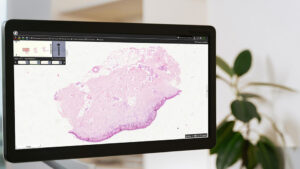Synopsis
Digitization offers many advantages for medical professionals and patients. In the past decades, working conditions were different with many challenges. Even when digitization kick-started, it was not common. At its core, digitization has increased work efficiency by improving laboratory workflow and setting standards for further development. Evolving features like scan sharing, high-quality equipment, and artificial intelligence are continuously changing the workflow of digital laboratories. This development has also had a positive impact on other fields such as radiology, leading to progress and quality in modern healthcare and treatment of patients.
Introduction
Digital pathology is a dynamic environment. It is characterized by the acquisition, management, and interpretation of pathology information generated by digital slides. Digitalization has brought benefits to many aspects of the healthcare system, including initial diagnosis, intraoperative diagnosis, medical training, diagnostic consultation, auditing, and clinical research. The advantages of digitization in pathology and histopathology are big, here are the 10 core benefits that digital pathology is set to bring in.
1. Increased Workflow Efficiency
Digital pathology improves laboratory workflow and connectivity and enhances your power to share digital slides and data and sets the standard for facilitating further advances. To accomplish this, medical organizations must invest in infrastructure to support the progress of digital pathology. That means making pathology a priority when allocating IT resources, engaging with IT and informatics to improve existing digital infrastructure, setting up a suitable data storage solution, and ensuring that the digital network can withstand the diverse demands of the profession.
2. High-resolution Slide Scan Sharing
One of the major advantages of digitization is the possibility of sharing scans between pathologists and other medical experts. Moving physical slides between locations is expensive and inefficient, so creating and using digital slides is more efficient. To work with a digital setup, you require a scanning device to capture glass slides to produce high-resolution images that can be viewed on a computer or mobile device.
3. Investment in Equipment
The switch to digitization can be an expensive affair for pathology laboratories. However, those who have embarked on the digitization journey claim that the investment is worth it. The successful implementation of digitization in pathology laboratories at Conquest Hospital and Eastbourne District General Hospital shows that laboratories can intelligently speed up testing, reduce errors, manage increased demand, and reduce costs. Digitization saved 20% of the pathology costs of these organizations which they plan to reinvest into local healthcare and use the amount to manage the rising number of samples received every year.
4. Artificial Intelligence
Artificial intelligence (AI) has changed the status quo of digital pathology and digital histopathology lab. The use of AI makes this field more robust, and more producible and pushes the field from purely qualitative to a quantitative area.
- Google’s Verily teamed up with Lumea to improve prostate cancer diagnosis and prognosis.
- Roche collaborated with Bristol Myers Squibb to develop and deploy two new digital pathology algorithms.
- PreciseDx, a spin-off of Mount Sinai Systems, has developed an artificially intelligent digital pathology technology for the detection of Parkinson’s disease.
- Medical technology company PreciPoint GmbH’s PreciAI also provides end-to-end imaging solutions for users in the digital pathology market. PreciPoint offers life science researchers solutions for microscopy, biological image analysis, and data management as part of an attractive product portfolio. PreciAI makes customers benefit from streamlined workflows and creates new possibilities for image analysis.
5. Biotechnology for Precision Medicine
A variety of digital technologies have improved point-of-care testing (PoCT) options in digital pathology departments. PoCT enables the examination of tissues, body fluids, and other samples to be performed to facilitate patient management. UK startup Oxford Nanopore Technologies offers real-time, out-of-lab DNA and RNA sequencing with its MinION device. Researchers can perform offline DNA sequencing using only a handheld device. Tools like this give precious information on how patients react to treatment and prognosis.
6. Benefits for Radiology and Other Fields
Due to rapid changes in digital imaging methods in the last few years, the field of pathology is transforming faster than any other medical specialty. Digital pathology affects radiology, dermoscopy, and other disciplines by increasing the quality of medical service. Pathologists and radiologists look at anatomies through imaging devices, however, one of them examines at the cellular level and the other at the organ level. Due to the rapid changes in digital imaging methods in the last few years, both fields are transforming very quickly.
7. Meeting Expectations
The Covid-19 pandemic proved that changes regarding digitization in medicine are possible. The wide availability of rapid Covid-19 diagnostics changed the patient’s attitude and now they are demanding faster turnaround. Several medical experts believe that digital pathology will inevitably become the standard of care in the future.
8. Removing the Geographic Limitations
The efficiency of digital pathology also depends on geographic location. Digital pathology labs are more efficient when geographic limitations are eliminated. Digitization allows you to benefit from more advanced technology, primarily artificial intelligence tools, including machine learning for whole slide imaging, deep learning, and computer-aided algorithms. Pathologists and medical experts who are geographically separated can easily collaborate to establish the diagnosis and make subsequent decisions.
9. New Approaches
Digital pathology systems open new possibilities for pathologists who can further improve the quality of care and patient treatment. A new Dell Technologies Digital Twin Initiative uses technology to leverage digital pathology imaging to identify groups of patients with similar diagnoses and search for correlations.
10. Promising Future
The digitalization of pathology and histopathology holds great promise. It is expected that this movement will contribute to the accurate and efficient acquisition and querying of data, mainly with the help of artificial intelligence. This collaboration is expected to enhance data interpretation and its integration with diagnostic and therapeutic processes.
Conclusion
Digitization has revolutionized digital pathology and histopathology. It offers several advantages and benefits that were previously lacking in digital laboratories. Digitization in pathology helps in increased workflow efficiency, easy sharing of knowledge, use of high-quality equipment, use of artificial intelligence such as PreciAI, and benefits in biotechnology and other fields, removing the geographic limitations, providing new approaches, and having scope for potential growth in the future. To achieve that growth, it is necessary to invest in the infrastructure needed; successful examples have proved that investment pays off. Undoubtedly, the route ahead is digital microscopy and digitization.











